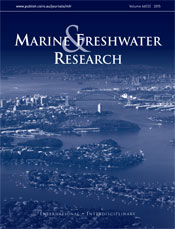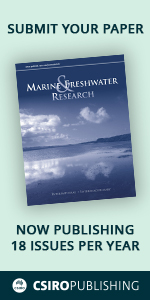Marine and Freshwater Research
Volume 66
Number 12 2015
Ports and harbours are the hubs of modern society, where both the world’s wealth and the world’s population are concentrated. Unfortunately, these areas are being subjected to several stressors worldwide, such as contamination and habitat modification. Synthesising current knowledge is the first step in establishing a coordinated, strategic and comprehensive management plan in order to recover and conserve these systems. In this edition of Marine and Freshwater Research we present two major reviews of what is possibly the world’s most biologically diverse port – Sydney Harbour. The first review is of the biophysical aspects of the Harbour (Johnston et al. 2015), whereas the second review is a detailed inventory and interpretation of threats and stressors (Mayer-Pinto et al. 2015). The issues summarised for Sydney Harbour are common to major urban and industrialised estuaries around the globe.
Sydney Harbour is a hotspot for marine diversity and one of the largest urbanised harbours in the world. This is the first comprehensive synthesis of the ecological and biophysical aspects of Sydney Harbour. A greater understanding of how the Harbour works and what drives its diversity is crucial to ensuring the sustainable use of this estuary for the well being of all.
Sydney Harbour is a hotspot for marine diversity; however, this iconic place has been heavily affected by its urban past through coastal development, resource extraction, pollution and shipping to name a few. This is the first comprehensive synthesis of the threats and impacts to the natural habitats of Sydney Harbour. A greater understanding of the current and past threats to the Harbour and their impacts is crucial to devise clear conservation, restoration and sustainability plans for the Harbour and for similarly urbanised estuaries worldwide.
Top down–bottom up is one of the major hypotheses that explain aquatic communities’ structure. In this study we aim to prove it in a subtropical shallow lake using phytoplankton as study object. We realised that phytoplankton is mainly regulated by hydrological changes that affect nutrient availability and predation. Evidence suggest that top down–bottom up model is not completely valid for shallow subtropical lakes where new models should be fashioned.
Although age and growth of blue marlin (Makaira nigricans) have been studied for decades, no results are generally accepted to date. The present study described the growth of blue marlin from juvenile to adult stages using otolith micro-increment and sectioned fin spine analyses first time. Obtained results will largely improve the stock assessment of the species.
No attempt has been made to link the energy demands of platypuses with the productivity of their invertebrate prey. In the upper Shoalhaven River, New South Wales, we measured total invertebrate production of 7.8 to 13.1 g DW m–2 year–1 over 2 years. These levels of production were sufficient to support 20–34 platypuses along a 1.5-km reach of the river
Many wetland plants and invertebrates in wetland communities survive the dry periods as dormant seeds and eggs. We determined that the viability of seeds decreased at temperatures at above 50°C and for invertebrates at temperatures at above 40°C. These results indicate that changes to sediment temperature during the dry phase of wetlands may play an important role in influencing communities of wetland plants and invertebrates.
Our study proposes that metabolism and proportion of calcite and aragonite are tightly related, being sensitive to changes in environmental parameters and varying geographically where calcite is favoured over aragonite toward high latitudes.
A recent dramatic decline in the settlement of post-larvae of the Western Australian spiny lobster may be due to changes in the offshore oceanographic processes. This research reported that late-stage phyllosomas of spiny lobster in cyclonic eddies of the Leeuwin Current are in a substantially better nutritional condition than are those in anticyclonic eddies. These differences may be related to differences in water temperatures and would influence their settlement.
Ciguatera fish poisoning is frequent in southern coastal China. Ciguatera toxins (CTXs) in wild coral reef fish collected from the southern coast of China were analysed, and 47.8% of the samples were confirmed to be contaminated with CTXs. There was no significant correlation between fish toxicity and fish weight, length and feeding habits. The present study posed a huge question concerning the management of ciguatera toxins in China.
Growth and spatiotemporal distribution of juvenile shortfin mako provide valuable information on their potential productivity, mechanisms of recruitment and movement. The aims of this study were to estimate the growth and to explore the distribution. The shortfin mako growth was faster than previously reported – sharks were born during autumn and winter off the coast of north-eastern Japan, and gradually expanded their habitat eastward and northward.
What drives variation in estuarine epibiota community structure? By testing relationships among multiple environmental factors, various biogenic substrates and the richness and abundance of epibiota, this study investigates possible underlying drivers of variation in epibiotic communities. The results clearly demonstrate the importance of including multiple environmental factors in future studies to provide better prediction of the distribution and changes of epibiota communities.
The genetic structure of bottlenose dolphin communities found along the southern Brazilian coast reveals the presence of three distinct clusters, with low gene flow between dolphins of Laguna and those from outside the estuary. Despite the movement of some individuals among the areas, significant genetic structure between dolphins was observed even among those from nearby estuaries (~219 km apart). Most of the stranded samples were revealed to be part of a possible offshore population (Cluster 3) with high levels of genetic diversity, whereas the others specimens were divided into two coastal groups (Cluster 1 and Cluster 2)
This study provides the first direct observations of dusky sharks attacking a humpback whale calf. Although the bites, from up to 20 dusky sharks, were superficial, the whale calf eventually drowned from stress and exhaustion. These observations provide a new insight into the potential threat that dusky sharks may pose to whale calves.
This research investigates whether sampling techniques for capturing eggs of the threatened Prototroctes maraena can be improved to monitor spawning success. Paired drift net sets (just below the surface v. on the bottom) were compared to identify that most eggs (90%) were captured on bottom and as a result egg density was higher. Recommendations are made for future sampling and implications for other species with negatively buoyant eggs discussed.




